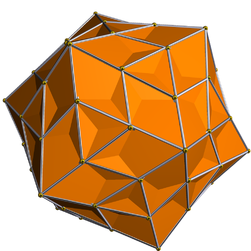Snub dodecadodecahedron
| Snub dodecadodecahedron | |
|---|---|

| |
| Type | Uniform star polyhedron |
| Elements | F = 84, E = 150 V = 60 (χ = −6) |
| Faces by sides | 60{3}+12{5}+12{5/2} |
| Coxeter diagram | |
| Wythoff symbol | | 2 5/2 5 |
| Symmetry group | I, [5,3]+, 532 |
| Index references | U40, C49, W111 |
| Dual polyhedron | Medial pentagonal hexecontahedron |
| Vertex figure |  3.3.5/2.3.5 |
| Bowers acronym | Siddid |

In geometry, the snub dodecadodecahedron is a nonconvex uniform polyhedron, indexed as U40. It has 84 faces (60 triangles, 12 pentagons, and 12 pentagrams), 150 edges, and 60 vertices.[1] It is given a Schläfli symbol sr{5⁄2,5}, as a snub great dodecahedron.
Cartesian coordinates
Cartesian coordinates for the vertices of a snub dodecadodecahedron are all the even permutations of
- (±2α, ±2, ±2β),
- (±(α+β/τ+τ), ±(-ατ+β+1/τ), ±(α/τ+βτ-1)),
- (±(-α/τ+βτ+1), ±(-α+β/τ-τ), ±(ατ+β-1/τ)),
- (±(-α/τ+βτ-1), ±(α-β/τ-τ), ±(ατ+β+1/τ)) and
- (±(α+β/τ-τ), ±(ατ-β+1/τ), ±(α/τ+βτ+1)),
with an even number of plus signs, where
- β = (α2/τ+τ)/(ατ−1/τ),
where τ = (1+√5)/2 is the golden mean and α is the positive real root of τα4−α3+2α2−α−1/τ, or approximately 0.7964421. Taking the odd permutations of the above coordinates with an odd number of plus signs gives another form, the enantiomorph of the other one.
Related polyhedra
Medial pentagonal hexecontahedron
| Medial pentagonal hexecontahedron | |
|---|---|

| |
| Type | Star polyhedron |
| Face | 
|
| Elements | F = 60, E = 150 V = 84 (χ = −6) |
| Symmetry group | I, [5,3]+, 532 |
| Index references | DU40 |
| dual polyhedron | Snub dodecadodecahedron |

The medial pentagonal hexecontahedron is a nonconvex isohedral polyhedron. It is the dual of the snub dodecadodecahedron. It has 60 intersecting irregular pentagonal faces.
See also
References
- ^ Maeder, Roman. "40: snub dodecadodecahedron". MathConsult.
{{cite web}}: CS1 maint: url-status (link)
- Wenninger, Magnus (1983), Dual Models, Cambridge University Press, doi:10.1017/CBO9780511569371, ISBN 978-0-521-54325-5, MR 0730208
External links
- Weisstein, Eric W. "Medial pentagonal hexecontahedron". MathWorld.
- Weisstein, Eric W. "Snub dodecadodecahedron". MathWorld.
